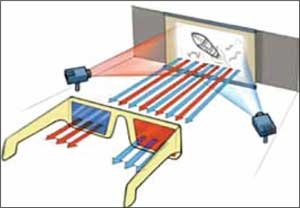As the cinematic experience radically changed from B&W to colour and the current 3D/4D/6D, so did the TVs in our homes. Bulky TV sets have given way to slim LCD and LEDs TVs—more recently, those equipped with 3D technology.
India is on the verge of 3D boom. The same kind of glasses as provided in movie theatres are required to enjoy a 3D movie in 3D effect on a 3D TV set. If you remove these glasses and watch the same movie with naked eyes, the incredible 3D experience would vanish and you would land up viewing distorted/blurred pictures.
Clearly, 3D glasses are indispensable to enjoying 3D effect. Here is how these create the 3D effect.
Fundamentals
The 3D effect relies on creating an illusion of depth to the viewer. To understand what this means, simply watch your thumb with both your eyes, then close one eye as you keep watching the thumb with the other eye. Now close this eye and open the previous one. Repeat this twice or thrice. You will see as if the thumb is shifting back and forth. This back and forth distance basically arises due to the depth created in visualising the thumb with different eyes.
This simple phenomenon is the basis for developing the 3D glasses. The movie screen actually displays two images. The glasses are designed to feed different images into our eyes. These let one of the images to enter one eye and the other image to enter the other eye. This is achieved using either of two ways: red/green or red/blue 3D glasses, and polarisation.

Red/green or red/blue 3D glasses
In this system, to produce the 3D effect, two images are displayed on the screen—one in red and the other in green or blue. The colour filters on the glasses allow only one image to enter each eye. This lends depth to the image, making it appear 3D to our brain.
However, the image quality with this method is not as good as with the polarised system. The reason is it somehow restricts some of the actual colours of the scene as it applies filtration by means of the colour itself.
Polarisation
This method uses differently polarised lenses to feed different images into our eyes. The system comprises two synchronised projectors to project two respective views of an image, each with a different polarisation. The glasses have a pair of differently polarised filters at 90 degrees to each other. As each filter passes only that light which is similarly polarised and blocks the light polarised in the opposite direction, each eye sees a different image. Thus two different images reach our eyes, creating a sense of depth leading to very high-quality 3D effect.
The author is a software engineer at AMDOCS DVCI, Pune







